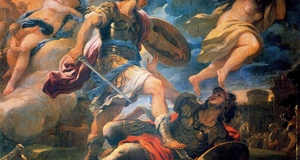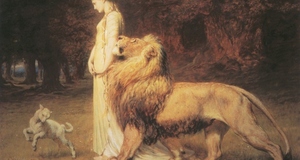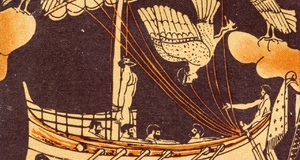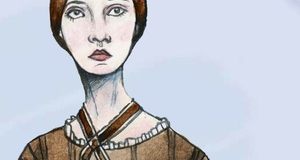|
From Discussions VOL. 5 NO. 2 Four Lines to Immortality: Dido's Renaissance Through Josquin des Prez
Dido's apparent lack of free will suggests an interesting interpretation of her character. If one looks upon the queen as a miserable pawn in Aeneas' destiny, meant to derail his search for Rome by vindictive deities, then her story becomes sympathetic. Dido becomes a victim of the gods in a game gone horribly awry. Thus, the true Dido is a strong, chaste woman ruling her city without a husband, before she is led astray by lust. It is this victimization that seems to have inspired Renaissance characterizations of Dido as the pure queen brought to ruin by Fate.
Dido is not only a pawn of the gods; she is also used as a poetic tool, meant only to serve as Aeneas' foil and display how his destiny could fall apart through love. She is the mirror of Aeneas; after all, "Both are widowed and in exile, both are obeying commands to found a new city and serve as its magistrate..." (Schmalfeldt, 588). Dido represents everything he is meant to achieve as the fated ruler of a thriving city.19 This aspect shows her strength and the source of her pride.
Virgil, for all of his poetic genius and classical hexameters, might never have imagined a future in which he would be hailed as a prophet of a Messiah or an inspiration for dozens of musical compositions. While Virgil's poetry glorifies the ideals and virtues of his native Roman Empire, the artistic resonance of Dido has been felt across disciplines for centuries. Yet without the reception of his texts as Christian allegory, the fascination with Virgil might never have occurred in the middle ages. Sacred interpretation is what caused the Aeneid to be canonized in the fifteenth century, and this reevaluation of the epic allowed Dido to be reborn as an unwitting victim and not relegated to the role of godless temptress.
Virgil became a symbol of Christian prophecy. Likewise, his works gained new life centuries later in motet settings of his poetry. This shift is where the true value of the epic becomes apparent. Through fictionalization, Dido evolves into a contemporary of Aeneas, temporally displaced three hundred years to the aftermath of the Trojan War. Her kingdom symbolizes the destruction of love at the hands of the gods, the incredible sacrifice that the deities are willing to make for the life of one man. The sacrifice of the gods is not simply one human life, but the death of an entire civilization for the sake of the Roman race. Dido has become a tragic heroine, monolithic symbol far beyond the flesh.
Ironically, Virgil gained immortality in the Renaissance not through his hero Aeneas, but through a broken queen, a victim of fate and spurned love. Dido's farewell imparts a melancholy journey to the realm of the dead which inspired Josquin and subsequent composers to set her final speech to music. Josquin's motet interpreted Dido not as one of the many spurned women of antiquity, but as a proud symbol of acceptance. The queen's final words become evocative subjects for musical invention, and Josquin's emphasis on repetition and clarity of text declamation demonstrate a reverence for the meaning of the words. For all of the viable poetry in book four of the Aeneid, Josquin's chose to single out four lines that both immortalized Dido in music and portrayed her as a wronged heroine. The Aeneid thus became a permanent source for musical allusion that ensures that Dido will eternally go to her grave with her proud name intact.
I would like to give heartfelt thanks to all of the incredible professors that made her research possible and gave guidance every step of the way; her thesis advisor, Dr. David Rothenberg, her capstone advisor, Dr. Daniel Goldmark, and her mentors, Dr. Mary Davis and Dr. Kathleen Horvath.
Crane, Gregory R. (ed.) The Perseus Project, http://www.perseus.tufts.edu, February, 2008.
Dryden, John, translated. The Aeneid. http://www.perseus.tufts.edu, February, 2008.
Edgeworth, R.J. "The Death of Dido," The Classical Journal, 72.2 (Dec. 1976-Jan 1970): 129-133.
Guentner, Francis J. "Dulces exuviae in Sixteenth Century Music," The Classical Journal, 68.1 (Oct.-Nov., 1972): 62-67.
Holford-Strevens, Leofranc. "'Her Eyes Became Two Spouts': Classical Antecedents of Renaissance Laments," Early Music 27.3 , Laments (August 1999): 379-393.
Hollander, Robert. Expanded version of the article "Virgil." Dante Encyclopedia. Ed. Richard Lansing. New York: Garland Publishing, Inc, 2000.
Huelgas Ensemble dir. Paul van Nevel. Josquin des Prez. "Dulces Exuviae." Le Chant de Virgile. Harmonia Mundi Fr., 2001.
Hunter, James m. "Ovid Heroides VII" An Ongoing Translation of Ovid's Heroides. 31 October 2008.
MacKail, J.W. (translated) The Eclogues of Vergil. http://www.sacredtexts.com/cla/virgil/ecl/index.htm, March, 2008. "Motet." The Harvard Dictionary of Music. Ed. Don Michael Randel. 4th ed. Cambridge, Massachusetts and London,
England: The Belknap Press of Harvard University Press, 2003.
MOTET online database. Dr. Jennifer Thomas. Revised May 10th, 2008. Univeristy of Florida. May 18th, 2008. http:// www.arts.ufl.edu/motet/default.asp
"Motet." The Oxford Dictionary of Music, 2nd ed. rev. Ed. Michael Kennedy. Oxford Music Online. 16 Mar. 2009 .
Ovid. "Epistulae Heroidum: VII Dido Aeneae." The Latin Library. Posted by David J. Califf from an original edition. 31 October 2008.
Schmalfeldt, Janet. "In Search of Dido," The Journal of Musicology, 18.4 (Autumn 2001): 584-615. Seay, Albert. "Classical Metrics and Medieval Music," The Bulletin of the Rocky Mountain Modern Language Association, 23.2 (June 1969): 59-67.
Strunk, W. Oliver. "Virgil in Music," The Musical Quarterly, 16.4 (October 1930): 482-497.
Thomas, Jennifer. "Motet Online Database." Dulces Exuviae. 10 May 2008. University of Florida. 2 November 2008.
Thompson, James Westfall. "Vergil in Mediaeval Culture," The American Journal of Theology, 10.4 (October 1906): 648662.
Townend, G.B. "Changing Views of Virgil's Greatness," The Classical Journal, 56.2 (November 1960): 67-77. Williams, Theodore C, translated. The Aeneid. http://www.perseus.tufts.edu, February 2008. Wills, Garry, trans. The Confessions of St. Augustine. New York: Penguin Classics Deluxe Edition, 2006.
- Virgil, Aeneid, 4:651-654, trans. John Dryden. For translations of the passages immediately surrounding the dulces exuviae text, see Appendix One.
- A form of short unaccompanied choral composition...in use from 13th to early 16th cents. In 13th, 14th, and 15th cents. the motet was exclusively sacred and was based on a pre-existing melody and set of words to which other melodies and words were added in counterpoint. Oxford.
- See appendix two for a listing of motet settings of the Dulces exuviae
- Edgeworth quotes directly from Horace White's eloquent translation of Appian.: Appian VIII.xix. 13 1 , trans. Horace White, I (London 1912 [Loeb Classical Library]) 635-637
- Edgeworth draws a symbolic connection between the fiery deaths of the two queens: "The detail of the blazing pyre, which seemed to serve no purpose in the poem, has been added in order to suggest the blazing fall of Carthage."
- See Appendix Four for a full translation of Heroides VII by James m. Hunter.
- Phrygia was a kingdom in ancient Anatolia, and is used as a descriptive epithet for Aeneas.
- Dactylic hexameter is a metrical scheme utilized in Greek and Roman epic poetry. It consists of lines with six metrical feet broken up into dactyls (a long syllable followed by either another long syllable or two short ones).
- See appendix two for a listing of all the occurrences of the Dulces Exuviae text.
- Any melodic or harmonic progression which has come to possess a conventional association with the ending of a comp., a section, or a phrase. Oxford.
- Included as Appendix Three. All references to measure numbers are to this edition.
- Specifically in Mabriano de Orto and an Anonymous setting from the Bernard Thomas edition
- A group of more than five or six notes sung to a single syllable. Oxford.
- Simultaneously sounding musical lines according to a system of rules. Oxford.
- An Eclogue is a lyrical poetic form which typically contains pastoral imagery.
- When Constantine the Great in 324 A.D. publicly declared the establishment of Christianity as the religion of the Empire, he quoted the Fourth Eclogue as an important testimony to the recognition of the new faith by Rome's greatest poet. This gave Virgil a posthumous reputation as a sort of potential Christian before his time, to be classed in a way with the great Hebrew prophets, though somehow possessing a fuller understanding of the Christian spirit than any of them. Townend, 71,
- See Appendix Three for a full translation of the Eclogue by J.W. MacHail
- Schmalfeldt led the way to the original quotation: Perhaps the most notable example is to be found in the Confessions of St. Augustine (354-430 A.D.), where the early Church father looks back on his school days in Carthage and reproaches himself for having wept then over the death of Virgil's Dido when he should have been weeping over his own youthful alienation from God.
- Or, in Schmalfeldt's opinion on page 588, Dido is not a mirror but a foil for Aeneas. She gives a chart that highlights the pair's opposition. For example, whereas Aeneas is "driven by duty and honor-as public, supra-personal virtues," Dido is "driven by love-a private, individual emotion, thus, potentially subversive and socially disruptive." Or, Aeneas is "rational and strives for order" while Dido "becomes irrational and creates chaos."
Crane, Gregory R. (ed.) The Perseus Project, http://www.perseus.tufts.edu, February, 2008.
Dryden, John, translated. The Aeneid. http://www.perseus.tufts.edu, February, 2008.
Edgeworth, R.J. "The Death of Dido," The Classical Journal, 72.2 (Dec. 1976-Jan 1970): 129-133.
Guentner, Francis J. "Dulces exuviae in Sixteenth Century Music," The Classical Journal, 68.1 (Oct.-Nov., 1972): 62-67.
Holford-Strevens, Leofranc. "'Her Eyes Became Two Spouts': Classical Antecedents of Renaissance Laments," Early Music 27.3 , Laments (August 1999): 379-393.
Hollander, Robert. Expanded version of the article "Virgil." Dante Encyclopedia. Ed. Richard Lansing. New York: Garland Publishing, Inc, 2000.
Huelgas Ensemble dir. Paul van Nevel. Josquin des Prez. "Dulces Exuviae." Le Chant de Virgile. Harmonia Mundi Fr., 2001.
Hunter, James m. "Ovid Heroides VII" An Ongoing Translation of Ovid's Heroides. 31 October 2008.
MacKail, J.W. (translated) The Eclogues of Vergil. http://www.sacredtexts.com/cla/virgil/ecl/index.htm, March, 2008. "Motet." The Harvard Dictionary of Music. Ed. Don Michael Randel. 4th ed. Cambridge, Massachusetts and London,
England: The Belknap Press of Harvard University Press, 2003.
MOTET online database. Dr. Jennifer Thomas. Revised May 10th, 2008. Univeristy of Florida. May 18th, 2008. http:// www.arts.ufl.edu/motet/default.asp
"Motet." The Oxford Dictionary of Music, 2nd ed. rev. Ed. Michael Kennedy. Oxford Music Online. 16 Mar. 2009 .
Ovid. "Epistulae Heroidum: VII Dido Aeneae." The Latin Library. Posted by David J. Califf from an original edition. 31 October 2008.
Schmalfeldt, Janet. "In Search of Dido," The Journal of Musicology, 18.4 (Autumn 2001): 584-615. Seay, Albert. "Classical Metrics and Medieval Music," The Bulletin of the Rocky Mountain Modern Language Association, 23.2 (June 1969): 59-67.
Strunk, W. Oliver. "Virgil in Music," The Musical Quarterly, 16.4 (October 1930): 482-497.
Thomas, Jennifer. "Motet Online Database." Dulces Exuviae. 10 May 2008. University of Florida. 2 November 2008.
Thompson, James Westfall. "Vergil in Mediaeval Culture," The American Journal of Theology, 10.4 (October 1906): 648662.
Townend, G.B. "Changing Views of Virgil's Greatness," The Classical Journal, 56.2 (November 1960): 67-77. Williams, Theodore C, translated. The Aeneid. http://www.perseus.tufts.edu, February 2008. Wills, Garry, trans. The Confessions of St. Augustine. New York: Penguin Classics Deluxe Edition, 2006.
Endnotes
- Virgil, Aeneid, 4:651-654, trans. John Dryden. For translations of the passages immediately surrounding the dulces exuviae text, see Appendix One.
- A form of short unaccompanied choral composition...in use from 13th to early 16th cents. In 13th, 14th, and 15th cents. the motet was exclusively sacred and was based on a pre-existing melody and set of words to which other melodies and words were added in counterpoint. Oxford.
- See appendix two for a listing of motet settings of the Dulces exuviae
- Edgeworth quotes directly from Horace White's eloquent translation of Appian.: Appian VIII.xix. 13 1 , trans. Horace White, I (London 1912 [Loeb Classical Library]) 635-637
- Edgeworth draws a symbolic connection between the fiery deaths of the two queens: "The detail of the blazing pyre, which seemed to serve no purpose in the poem, has been added in order to suggest the blazing fall of Carthage."
- See Appendix Four for a full translation of Heroides VII by James m. Hunter.
- Phrygia was a kingdom in ancient Anatolia, and is used as a descriptive epithet for Aeneas.
- Dactylic hexameter is a metrical scheme utilized in Greek and Roman epic poetry. It consists of lines with six metrical feet broken up into dactyls (a long syllable followed by either another long syllable or two short ones).
- See appendix two for a listing of all the occurrences of the Dulces Exuviae text.
- Any melodic or harmonic progression which has come to possess a conventional association with the ending of a comp., a section, or a phrase. Oxford.
- Included as Appendix Three. All references to measure numbers are to this edition.
- Specifically in Mabriano de Orto and an Anonymous setting from the Bernard Thomas edition
- A group of more than five or six notes sung to a single syllable. Oxford.
- Simultaneously sounding musical lines according to a system of rules. Oxford.
- An Eclogue is a lyrical poetic form which typically contains pastoral imagery.
- When Constantine the Great in 324 A.D. publicly declared the establishment of Christianity as the religion of the Empire, he quoted the Fourth Eclogue as an important testimony to the recognition of the new faith by Rome's greatest poet. This gave Virgil a posthumous reputation as a sort of potential Christian before his time, to be classed in a way with the great Hebrew prophets, though somehow possessing a fuller understanding of the Christian spirit than any of them. Townend, 71,
- See Appendix Three for a full translation of the Eclogue by J.W. MacHail
- Schmalfeldt led the way to the original quotation: Perhaps the most notable example is to be found in the Confessions of St. Augustine (354-430 A.D.), where the early Church father looks back on his school days in Carthage and reproaches himself for having wept then over the death of Virgil's Dido when he should have been weeping over his own youthful alienation from God.
- Or, in Schmalfeldt's opinion on page 588, Dido is not a mirror but a foil for Aeneas. She gives a chart that highlights the pair's opposition. For example, whereas Aeneas is "driven by duty and honor-as public, supra-personal virtues," Dido is "driven by love-a private, individual emotion, thus, potentially subversive and socially disruptive." Or, Aeneas is "rational and strives for order" while Dido "becomes irrational and creates chaos."
Suggested Reading from Inquiries Journal
In the Aeneid, Virgil depicts the struggle of the newly displaced Trojans to find a new home, under the leadership of Aeneas. The Trojans, having only recently lost the Trojan War to the Greeks, travel in search of a new home, eventually settling in Italy−to the dismay of some of the Italians. The motif of Troy... MORE»
Contrary to the scintillating promise of its title, Spenser’s Faerie Queene is a far cry from the insubstantial delights of light fantasy fiction. A narrative poem in six books, this hefty labyrinthine work chronicles the quests of the patron knights of six virtues through their perpetual stumblings... MORE»
The defining characteristics of Odysseus in classical literature are interpreted in wildly different ways by different authors: he is portrayed as a hero in Homer’s The Odyssey, a villain in Sophocles’ Philoctetes, a self-serving opportunist in Sophocles’ Ajax, a deceitful... MORE»
Born in 1830 to Calvinist parents in Massachusetts, Emily Dickinson is renowned as one of America’s greatest poets. Though her poems often focused on death, she in fact wrote on many subjects. Life, nature, love, science... MORE»
Latest in Literature
2023, Vol. 15 No. 02
This literary analysis compares the spiritual landscape of Aldous Huxley’s Brave New World against his nonfiction work, The Perennial Philosophy. In Brave New World, Huxley’s World State appears spiritually promising. It embeds self-... Read Article »
2022, Vol. 14 No. 09
Woolfian Scholars regularly denote the moments where Woolf’s characters feel inexplicably connected and inseparable from one another as representing the spiritual and mystic beliefs of their author. I want to reframe this notion, considering... Read Article »
2022, Vol. 14 No. 09
The Goldfinch (2013) by Donna Tartt is a novel that explores the conditions of grief and escalating lengths characters will go to survive the traumas and mysteries of life. This story of guilt and loss—intermixed with love and longing&mdash... Read Article »
2022, Vol. 14 No. 04
British Poet Laureate Carol Ann Duffy’s The World’s Wife presents a fresh outlook on myths and fairy tales, by retelling them through sociosexually liberated women. The poems feature many themes such as murder, sexuality and childhood... Read Article »
2022, Vol. 14 No. 04
The 17th and 18th centuries saw a wide proliferation of aesthetic discourse through which the picturesque emerged to capture the type of beauty derived from the exchange of in vivo vigor for the spirit of artistic medium. While the metaphysical... Read Article »
2022, Vol. 14 No. 03
This paper explores the complexity of Whitman’s nationalism and, with reference to Leaves of Grass (1856), examines the apparent paradox between Whitman’s poetry of love and recognition and his imperialistic impulses. This paper draws... Read Article »
2022, Vol. 14 No. 02
This article explores the expression of the Gothic romance genre in the 21st century, by examining Mike Flannagan’s The Haunting of Bly Manor. Very little literature focuses on contemporary expressions of this genre. The Gothic reflects the... Read Article »
|




















